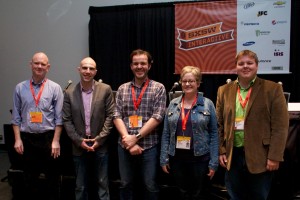Another SXSW has come and gone. Now that I’m back home and in withdrawal from the breakfast tacos, brisket and free drinks, I took a moment to reflect on my panel, Digital Immortals: Preserving Life Beyond Death. Speaking at SXSW is always a thrill, and this year was no exception.
My goal with the panel was to provide a more advanced discussion of how we might interact with our digital heirlooms in the future. I’d grown weary presenting the usual cautionary tale about digital estate planning and I believed it was time for a look into the future. I think we did just that.
I’m deeply grateful that Airdrie Miller, widow of blogger Derek Miller from Penmachine.com, agreed to join us. In her “turn of the century love story” she captured the essence of our shift to digital and through her experiences with Derek’s untimely death helped us to understand just why our digital lives are so important. But in a moment of balance, she also shared how sometimes Derek’s memory, while extremely important to her, shouldn’t be a daily reminder. The process of grieving, it seems, needs resolution and putting things away, be they digital or physical, is necessary.
Mashable’s Adam Ostrow, inspired by Derek Miller’s final post, shared his thoughts on a digitally preserved self. Someday the massive quantities of digital information we create and share today combined with advances in artificial intelligence and shear computational power might give us a realistic representation of self. This idea is a very real possibility and was the central theme for our panel discussion. Should we create a digitally preserved self? And what form might that take?
Getting down to details, Bill LeFurgy from the Library of Congress reminded us of our personal archiving habits, or more appropriately, our lack thereof. Through his story of “Uncle Dave,” one of the many Civil War photographs in the Library of Congress collection, he pointed out that in the future we won’t look to institutions to find record of our personal history, but to our personal collections. If we’re to consider the idea of a digitally preserved self, then we must take better care of our personal collections and ensure they have the appropriate metadata or annotations to convey the meaning of objects to people or computers in the future.
Richard Banks of Microsoft Research Cambridge and author of The Future of Looking Back, examined the difference between the physical and the digital, and the tradeoffs of shifting out sentimental objects from one to the other. Richard pointed out that our most sentimental objects aren’t necessarily secondary to the mundane ones, which will help others understand our lives from the day-to-day minutiae we now can preserve.
Through our panel discussion we generated a few themes:
- Today we create a massive amount of digital content, from the profound to the mundane.
- All of this content does indeed have value, regardless of our current perspective.
- As a society, we’re not good stewards of our own data through benign neglect.
- The tools of the future must have archiving tools built-in, automating the curation process to ensure that our personal data isn’t neglected.
- However we look back at the past, whether through a digitally preserved self, or through new interfaces, designers must understand how individuals reminisce, how they reflect and to what degree the past is welcome in their everyday life.
As an archivist at heart, it’s easy to get caught up in the idea that we can save everything and build tools to take care of it and perhaps we will be able to do that after all. As we design these systems, however, we must understand and embrace how humans interact with the past and maintain a proper balance of the present. If we violate this relationship, the past will be a burden on the present, and our personal identities will fade away.
More from our panel






I think it is a great idea. Those living speak to head stones of those who have preceded them in death…this has gone on for centuries. I believe that having a likeness or memoirs of the loved one is fabulous! There are numerous people who lived rather sheltered lives and being able to actually ‘tap’ into the mortal’s mind and heart in the hereafter, here would be wildly exciting.
Sometimes there are so many doubts with the living…wondering if they were really loved, wondering if the person who has passed thought of them in tender ways. It can assist in nullifying doubts that for most create walls of confusion and self-doubt. I love, love, love the idea!!!
I would immensely be appreciative and be able to embrace the availability to ‘send messages from the grave’, to keep in touch with my loved ones after the fact, to leave my thoughts for them to discover just how wonderful they are and just how important they were to me.
Bring it on brother! Amen!
Thanks for a great recap of SXSW. I actually live in Austin and have never been (though the breakfast tacos and brisket are favorites of mine).
I discovered your site as I am researching a post I am writing for my boomer oriented blog on this very issue. I fear too many boomers (of which I am one) have not given enough thought to their digital afterlife.
I’ve subscribed to your RSS feed and will continue to follow your work. Will probably buy the book as well!